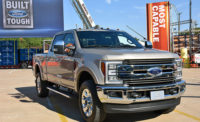Design and engineering teams at Ford Motor Co. have taken what might be thought of as a radically conservative approach to the new 2015 Ford F-150. Aside from a new grille and headlights, the latest F-150 looks familiar. The revolutionary step is the switch from steel to what Ford calls "military grade" aluminum in the body, cab and bed.
The payoff is 700 lb in weight savings, which contribute to more efficient braking, towing and increased payload capabilities, topping out at a hefty 3,300 lb. The truck's new skin also allows Ford to achieve better fuel economy, but those ratings are still a secret.
For those wondering how an aluminum-bodied, steel-framed pickup will hold up, Ford says not to worry. Modern aluminum alloys can be made as tough as steel at a fraction of the weight, and Ford has now put roughly 10 million miles on this all-new platform, including testing in mining, utility and construction sites.
Beyond New Materials
While that extensive use of aluminum has fueled great buzz among truckers, other details make this 13th-generation F-150 superior to the model it's replacing.
Some of the new differences are subtle, such as a restyled grille and headlights surrounded by a rim of amber LED accent lighting. As with earlier models, the new F-150 will be offered in the three traditional body styles, including regular cab; extended cab, or, in Ford-speak, SuperCab; and crew cab, or SuperCrew. There's also the usual trio of bed lengths available: a 5.5-ft-long short bed, a 6.5-ft midsize bed and a hard-working 8-ft bed.
Another big change is the variety of choices under the hood. Buyers can select from three V6 engines and a V8. The base engine, a 3.5-liter V6 that produces a modest 283 hp and 255 lb-ft of torque, offers a max payload and towing capacity of 1,910 lb and 7,600 lb, respectively.
Next up is a 2.7-liter, twin-turbocharged EcoBoost V6 that puts out an impressive 325 hp and 375 lb-ft, making it the engine for most contractors. The engine features an autostart-stop feature that can help boost fuel economy in stop-and-go traffic—it can be turned off manually—and has a payload capacity of 2,250 lb and a healthy towing capacity of 8,500 lb.
For applications when maximum muscle is required, Ford brings back the 5.0-liter V8, with 385 hp and 387 lb-ft, giving the truck a max payload rating of 3,300 lb and towing capacity of 11,100 lb. The V8 is not necessarily top dog, though. Ford carries over the 3.5-liter twin-turbo EcoBoost V6, which is rated at 365 hp and a massive 420 lb-ft of torque, offering payload ratings of 3,270 lb and a range-topping towing capacity of 12,200 lb.
The top-line EcoBoost engine is hardier, too. Some 2011-13 models reportedly misfired in humid weather due to condensation in the charge-air cooler, prompting the National Highway Traffic Safety Administration to investigate. Ford installed a deflector plate on them, and it was improved further for production. NHTSA closed the probe this past April.
Driving the new 2015 Ford F-150 in Texas' Hill Country, outside of San Antonio, demonstrated that, while the truck may not look radically new, its ride and handling feel noticeably more refined than the generation it is replacing.
The 2.7-liter twin-turbo EcoBoost was a strong performer, unfazed by the hilly two-lane roads. We also were able to drive a short loop pulling a 9,000-pound twin-axle box trailer with an F-150 powered by the available 3.5-liter twin-turbocharged EcoBoost V6, and, not surprisingly, the truck's 365 hp and 420 lb-ft handled uphill and downhill stretches with equal aplomb—a nice choice for heavy lifting.






Post a comment to this article
Report Abusive Comment